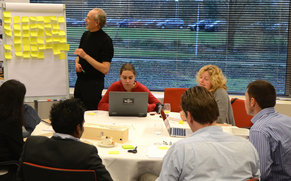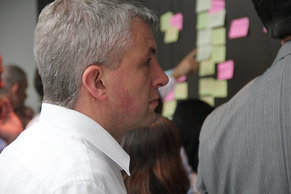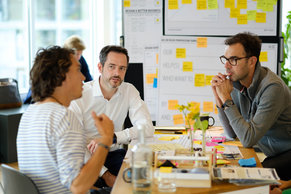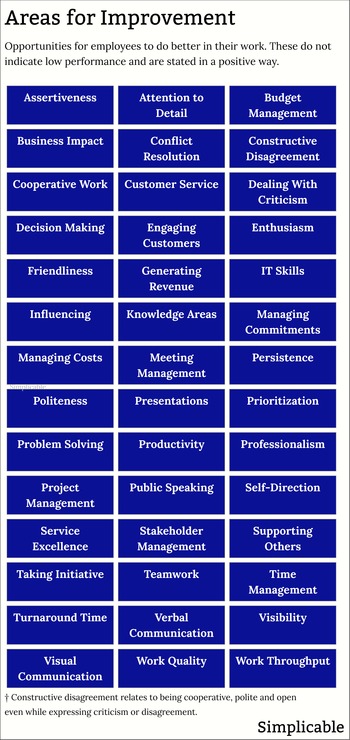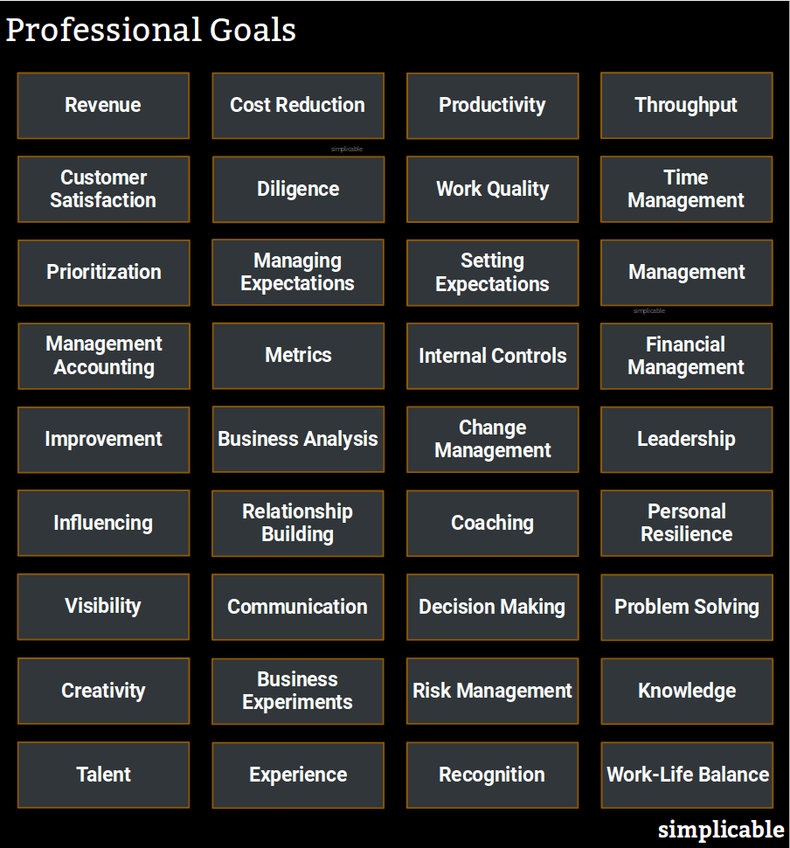
Revenue
Goals that can be directly measured in revenue such as closing more sales.Close sales worth $20,000 in MRR.
Cost Reduction
Goals that directly map to a cost reduction.Retire old software products to reduce license costs by $200,000 per year.
Productivity
A productivity goal is a target to increase the amount of value you create in an hour of work.Decrease time spent administering team budget by 30% by taking a class that introduces financial accounting for managers.
Throughput
Throughput is the amount of work you produce in a period of time.Clear more change requests. Measurement: increase my change request throughput to 50 story points a month.
Customer Satisfaction
Your performance from the perspective of customers.Improve service by listening carefully to customer concerns and acting to improve things for the customer. Measurement: improve customer satisfaction for my customers to 87%.
Diligence
Increase your diligence in a measurable way.Decrease my defect rate in code delivered to testing by at least 10% by fulling focusing on coding in quiet, uninterrupted work sessions.
Work Quality
Increasing the quality of your deliverables.Deliver quality software designs as measured by the work required to achieve stakeholder acceptance after the design is released for review. Target: gain acceptance of designs within an average of a week.
Time Management
Make better use of time.Spend 20% more time on my core projects by prioritizing work and managing expectations.
Prioritization
Prioritizing work to create more value.Prioritize sales opportunities to put more effort into proposals that have a greater chance of resulting in revenue. Measurement: improve win rate to 39%.
Managing Expectations
Managing the expectations of others such as the work that they imagine you are delivering. This represents the common reality that employees are often not free to prioritize their work independently but must deliver on obligations, both stated and assumed, to stakeholders.Clearly define and communicate commitments to stakeholders to increase stakeholder satisfaction with my deliverables to 97%.
Setting Expectations
Setting expectations is the process of assigning work to others and communicating what is expected of the work.Clearly communicate design standards to designers to improve client acceptance of deliverables to 80%.
Management
Management is the practice of directing people and controlling resources.Develop and implement a strategy to improve the resilience of production lines to reduce downtime to 0.1%.
Management Accounting
Management accounting is the practice of measuring things that managers need to know.Measure the performance of service desk requests to identify bottlenecks and failures. Target: measure and improve turnaround time of processes by 5%.
Metrics
Measuring things with metrics, often as a way to communicate your value as a professional or team.Measure customer satisfaction with service at the front desk. Goal: report customer satisfaction to show the value of service improvement initiatives. Measurement: capture customer satisfaction data from 5-10% of customers.
Internal Controls
Developing processes, practices and technologies that control resources.Implement a process and system for submitting change requests that creates transparency. Goal: 100% of change requests in system by Q3. Measurement: stakeholder satisfaction with change requests before/after the new process.
Financial Management
Managing budgets and financial processes such as purchasing.Perform a reconciliation that matches software licensing costs to actual software usage. Measurement: cost savings from retiring licenses that are unused.
Improvement
The process of measuring, improving and measuring again.Improve product designs to be more competitive in the market based on feedback collected from customers and lead users. Measurements: customer ratings, revenue, time to market.
Business Analysis
Business analysis is the practice of developing new knowledge, requirements and measurements.Sponsor a project to improve the customer service platform. Target: develop a full set of requirements by Q2 and achieve approval of budget by Q3.
Change Management
Change management is the practice of leading change that is likely to face organizational issues such as resistance to change.Sponsor a technology project and clear issues to see it delivered. Measurement: number of story points implemented for the customer relationship management system. Target: implement at least 100 story points
Leadership
Leadership is the process of influencing people to achieve common goals independently of your formal authority.Influence the technical direction of the team by developing and pitching ideas for infrastructure improvements. Measurement: develop and pitch at least 5 proposals.
Influencing
Changing peoples minds to influence their decisions and actions.Achieve budget approvals to hire and expand the team. Target: budget approval for two new hires this year.
Relationship Building
Developing business relationships with employees, partners, customers and industry peers.Attend industry conferences to develop contacts and leads. Goal: attend at least 3 conferences, add at least 100 contacts this year into our sales force management tool.
Coaching
Developing the talents of others with techniques such as knowledge of performance.Coach junior team members to improve their code. Measurement: feedback from junior team members.
Personal Resilience
Personal resilience is the ability to deal with situations others would find stressful without loss of professional composure and enthusiasm for your work. This is developed by taking on challenging action items to improve your ability to handle change, criticism and challenges.Take the lead on a project to represent project team with stakeholders. Measurement: feedback from stakeholders, budget variance, schedule variance
Visibility
Visibility is the degree to which people notice you in an organization or industry.Improve my visibility in the monthly IT governance meeting. Target: give at least 3 presentations in the meeting this year.
Communication
The process of communicating information, meaning and emotion.Better communicate the value of my design ideas to clients. Measurement: improve client acceptance of pitches to 70%.
Decision Making
Improving decision making.Create formal decision rationales to improve decision making. Measurement: document and communicate a rationale for 3-10 decisions.
Problem Solving
Solving long running problems or improving the process of solving regular problems.Perform a root cause analysis for information technology incidents. Measurement: identify and address root cause for 100% of severity 1 and 2 incidents.
Creativity
Creativity is the process of developing non-obvious ideas of value.Use design thinking to improve the efficiency of team meetings. Target: capture and resolve more issues, risks and action items in shorter meetings.
Business Experiments
Trying things that may fail as an experiment.Experiment with new processes for rapidly developing systems. Target: implement and measure two new processes on an experimental basis.
Risk Management
Reducing future losses by identifying and managing risks.Manage risks to projects to avoid issues that impact stakeholders. Target: identify and manage risks to reduce risk exposure across all the team's projects by 20%.
Knowledge
Developing or acquiring knowledge.Study and pass the _________ exam to achieve ________ certification.
Talent
Developing a talent.Improve my visual communication skills by designing and delivering visuals for communication, reporting and knowledge documentation. Measurement: feedback from stakeholders.
Experience
Gaining work experience in a particular area.Gain experience presenting products to customers. Target: complete 5-7 product demonstrations. Measurement: feedback from sales, closed deals and revenue related to customer presentations.
Recognition
Gaining recognition from management, peers, customers, partners and other stakeholders such as investors, media and communities.Gain recognition in the industry as a leading architect. Measurement: media coverage of my projects.
Work-Life Balance
Meeting your professional goals without sacrificing your personal goals.Prioritize, manage expectations and improve productivity to reduce overtime work. Measurement: no work on weekends, fewer overall work hours as compared to last year.



